by Calculated Risk on 3/07/2015 08:04:00 PM
Saturday, March 07, 2015
More Employment Graphs: Duration of Unemployment, Unemployment by Education, Construction Employment and Diffusion Indexes
By request, a few more employment graphs ...
Here are the previous posts on the employment report:
• February Employment Report: 295,000 Jobs, 5.5% Unemployment Rate
• Employment Report Comments and Graphs
 This graph shows the duration of unemployment as a percent of the civilian labor force. The graph shows the number of unemployed in four categories: less than 5 week, 6 to 14 weeks, 15 to 26 weeks, and 27 weeks or more.
This graph shows the duration of unemployment as a percent of the civilian labor force. The graph shows the number of unemployed in four categories: less than 5 week, 6 to 14 weeks, 15 to 26 weeks, and 27 weeks or more.The general trend is down for all categories, and both the "less than 5 weeks" and 6 to 14 weeks" are close to normal levels.
The long term unemployed is close to 1.7% of the labor force - the lowest since December 2008 - however the number (and percent) of long term unemployed remains a serious problem.
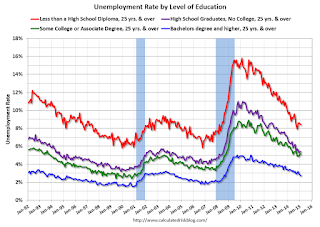 This graph shows the unemployment rate by four levels of education (all groups are 25 years and older).
This graph shows the unemployment rate by four levels of education (all groups are 25 years and older).Unfortunately this data only goes back to 1992 and only includes one previous recession (the stock / tech bust in 2001). Clearly education matters with regards to the unemployment rate - and it appears all four groups are generally trending down.
Although education matters for the unemployment rate, it doesn't appear to matter as far as finding new employment.
Note: This says nothing about the quality of jobs - as an example, a college graduate working at minimum wage would be considered "employed".
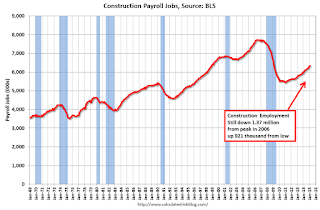 This graph shows total construction employment as reported by the BLS (not just residential).
This graph shows total construction employment as reported by the BLS (not just residential).Since construction employment bottomed in January 2011, construction payrolls have increased by 921 thousand.
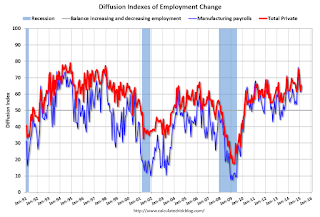 The BLS diffusion index for total private employment was at 65.4 in February, up from 62.0 in January.
The BLS diffusion index for total private employment was at 65.4 in February, up from 62.0 in January.For manufacturing, the diffusion index was at 64.4, up from 61.3 in January.
Think of this as a measure of how widespread job gains are across industries. The further from 50 (above or below), the more widespread the job losses or gains reported by the BLS. Above 60 is very good. From the BLS:
Figures are the percent of industries with employment increasing plus one-half of the industries with unchanged employment, where 50 percent indicates an equal balance between industries with increasing and decreasing employment.Overall job growth was widespread in February - another good sign.
Schedule for Week of March 8, 2015
by Calculated Risk on 3/07/2015 10:00:00 AM
The key economic report this week is February retail sales on Thursday.
Also the Census Bureau will release the Q4 Quarterly Services Report on Wednesday, and the Fed will release the Q4 Flow of Funds report on Thursday.
At 10:00 AM ET: The Fed will release the monthly Labor Market Conditions Index (LMCI).
7:30 AM ET: NFIB Small Business Optimism Index for February.
 10:00 AM: Job Openings and Labor Turnover Survey for January from the BLS.
10:00 AM: Job Openings and Labor Turnover Survey for January from the BLS. This graph shows job openings (yellow line), hires (purple), Layoff, Discharges and other (red column), and Quits (light blue column) from the JOLTS.
Jobs openings increased in December to 5.028 million from 4.847 million in November.
The number of job openings (yellow) were up 28% year-over-year, and Quits were up 12% year-over-year.
10:00 AM: Monthly Wholesale Trade: Sales and Inventories for January. The consensus is for a 0.1% decrease in inventories.
7:00 AM: The Mortgage Bankers Association (MBA) will release the results for the mortgage purchase applications index.
10:00 AM: The Q4 Quarterly Services Report from the Census Bureau.
4:30 PM: The Federal Reserve will release the Comprehensive Capital Analysis and Review Results (Stress Test)
8:30 AM: The initial weekly unemployment claims report will be released. The consensus is for claims to decrease to 309 thousand from 320 thousand.
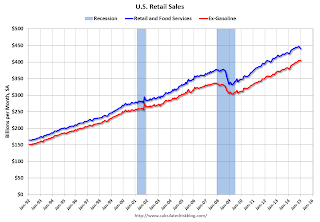 8:30 AM ET: Retail sales for February will be released.
8:30 AM ET: Retail sales for February will be released.This graph shows retail sales since 1992 through January 2015. This is monthly retail sales and food service, seasonally adjusted (total and ex-gasoline). On a monthly basis, retail sales decreased 0.8% from December to January (seasonally adjusted), and sales were up 3.3% from January 2014.
The consensus is for retail sales to increase 0.3% in February, and to increase 0.5% ex-autos.
10:00 AM: Manufacturing and Trade: Inventories and Sales (business inventories) report for January. The consensus is for a 0.1% increase in inventories.
12:00 PM: Q4 Flow of Funds Accounts of the United States from the Federal Reserve.
2:00 PM ET: The Monthly Treasury Budget Statement for February.
8:30 AM: The Producer Price Index for February from the BLS. The consensus is for a 0.3% increase in prices, and a 0.1% increase in core PPI.
10:00 AM: University of Michigan's Consumer sentiment index (preliminary for March). The consensus is for a reading of 95.5, up from 95.4 in February.
Friday, March 06, 2015
Duy: "Patient" is History
by Calculated Risk on 3/06/2015 06:00:00 PM
From Tim Duy at Fed Watch: "Patient" is History
The February employment report almost certainly means the Fed will no longer describe its policy intentions as "patient" at the conclusion of the March FOMC meeting. And it also keep a June rate hike in play. But for June to move from "in play" to "it's going to happen," I still feel the Fed needs a more on the inflation side. ...CR Note: Based on Yellen's testimony last week, it seemed likely that "patient" would be dropped from the March FOMC statement. June might be in play, but like Duy, I think the FOMC will wait until it is clear inflation is moving towards 2% before raising rates.
Bottom Line: "Patient" is out. Tough to justify with unemployment at the top of the Fed's central estimates of NAIRU. Pressure to begin hiking rates will intensify as unemployment heads lower. The inflation bar will fall, and Fed officials will increasingly look for reasons to hike rates rather than reasons to delay. They may not want to admit it, but I suspect one of those reasons will be fear of financial instability in the absence of tighter policy. June is in play.
emphasis added
Update: Best Private Sector Job Creation "Ever"?
by Calculated Risk on 3/06/2015 03:33:00 PM
Last month, I mentioned that private job creation was on pace for the best ever during a presidential term. I received a few emails asking if that was correct. The answer is "yes".
Note: We frequently use Presidential terms as time markers - we could use Speaker of the House, or any other marker.
Here is a table of the top three presidential terms for private job creation (they also happen to be the three best terms for total non-farm job creation).
Note: Overall employment was smaller in the '80s, however the participation rate was increasing in the '80s. The prime working age labor force was growing more than 3% per year in the '80s with a surge in younger workers and women joining the labor force. Now, the overall population is larger, but the prime working age population has declined this decade and the participation rate is generally declining now.
Clinton's two terms were the best for both private and total non-farm job creation, followed by Reagan's 2nd term. Public sector job creation increased the most during Reagan's 2nd term.
Currently Obama's 2nd term is on pace to be the best ever for private job creation. However, with very few public sector jobs added, Obama's 2nd term is only on pace to be the third best for total job creation.
Note: Only 34 thousand public sector jobs have been added during the first twenty five months of Obama's 2nd term (following a record loss of 702 thousand public sector jobs during Obama's 1st term). This is just 2% of the public sector jobs added during Reagan's 2nd term!
| Top Employment Gains per Presidential Terms (000s) | ||||
|---|---|---|---|---|
| Rank | Term | Private | Public | Total Non-Farm |
| 1 | Clinton 1 | 10,885 | 692 | 11,577 |
| 2 | Clinton 2 | 10,070 | 1,242 | 11,312 |
| 3 | Reagan 2 | 9,357 | 1,438 | 10,795 |
| Obama 21 | 5,799 | 34 | 5,833 | |
| Pace2 | 11,134 | 65 | 11,199 | |
| 125 Months into 2nd Term 2Current Pace for Obama's 2nd Term | ||||
The second table shows the jobs need per month for Obama's 2nd term to be in the top three presidential terms.
| Jobs needed per month (average) for Obama's 2nd Term | ||||
|---|---|---|---|---|
| to Rank | Private | Total | ||
| #1 | 221 | 250 | ||
| #2 | 186 | 238 | ||
| #3 | 155 | 216 | ||
Trade Deficit decreased in January to $41.8 Billion
by Calculated Risk on 3/06/2015 11:59:00 AM
Earlier the Department of Commerce reported:
The U.S. Census Bureau and the U.S. Bureau of Economic Analysis, through the Department of Commerce, announced today that the goods and services deficit was $41.8 billion in January, down $3.8 billion from $45.6 billion in December, revised. January exports were $189.4 billion, down $5.6 billion from December. January imports were $231.2 billion, down $9.4 billion from December.The trade deficit was at the consensus forecast of $41.8 billion.
The first graph shows the monthly U.S. exports and imports in dollars through January 2015.
 Click on graph for larger image.
Click on graph for larger image.Imports increased and exports decreased in January (some impact of West Coast port slowdown).
Exports are 14% above the pre-recession peak and down 2% compared to January 204; imports are at the pre-recession peak, and unchanged compared to January 2014.
The second graph shows the U.S. trade deficit, with and without petroleum, through January.
 The blue line is the total deficit, and the black line is the petroleum deficit, and the red line is the trade deficit ex-petroleum products.
The blue line is the total deficit, and the black line is the petroleum deficit, and the red line is the trade deficit ex-petroleum products.Oil imports averaged $58.96 in January, down from $73.64 in December, and down from $90.21 in January 2014. The petroleum deficit has generally been declining and is the major reason the overall deficit has declined since early 2012.
Note: There is a lag due to shipping and long term contracts.
The trade deficit with China increased to $28.6 billion in January, from $27.8 billion in January 2013. The deficit with China is a large portion of the overall deficit.
The decrease in the trade deficit was due to a lower volume and lower price of oil imports (volatile month-to-month), and a slightly larger deficit with the Euro Area ($8.0 billion in Jan 2015 compared to $7.2 billion in Jan 2014).
Employment Report Comments and Graphs
by Calculated Risk on 3/06/2015 09:45:00 AM
Earlier: February Employment Report: 295,000 Jobs, 5.5% Unemployment Rate
This was a very solid employment report with 295,000 jobs added, although job gains for January were revised down 18,000.
Unfortunately there was little good news on wage growth, from the BLS: "In February, average hourly earnings for all employees on private nonfarm payrolls rose by 3 cents to $24.78. Over the year, average hourly earnings have risen by 2.0 percent."
However I expect real wages to increase this year.
A few more numbers: Total employment increased 295,000 from January to February and is now 2.8 million above the previous peak. Total employment is up 11.5 million from the employment recession low.
Private payroll employment increased 288,000 from January to February, and private employment is now 3.2 million above the previous peak. Private employment is up 12.0 million from the recession low.
In February, the year-over-year change was 3.3 million jobs. This was the highest year-over-year gain since March '00.
Employment-Population Ratio, 25 to 54 years old

In the earlier period the participation rate for this group was trending up as women joined the labor force. Since the early '90s, the participation rate moved more sideways, with a downward drift starting around '00 - and with ups and downs related to the business cycle.
The 25 to 54 participation rate decreased in February to 81.0%, and the 25 to 54 employment population ratio increased to 77.3%. As the recovery continues, I expect the participation rate for this group to increase a little more (or at least stabilize for a couple of years) - although the participation rate has been trending down for this group since the late '90s.
Average Hourly Earnings

The blue line shows the nominal year-over-year change in "Average Hourly Earnings" for all private employees. Nominal wage growth has been running close to 2% since 2010 and will probably pick up a little this year.
Note: CPI has been running under 2%, so there has been some real wage growth.
Part Time for Economic Reasons

The number of persons employed part time for economic reasons (sometimes referred to as involuntary part-time workers) was little changed in February at 6.6 million. These individuals, who would have preferred full-time employment, were working part time because their hours had been cut back or because they were unable to find a full-time job.The number of persons working part time for economic reasons decreased in February to 6.635 million from 6.810 million in January. This is the lowest level since September 2008. This suggests slack still in the labor market. These workers are included in the alternate measure of labor underutilization (U-6) that decreased to 11.0% in February from 11.3% in January. This is the lowest level for U-6 since September 2008.
Unemployed over 26 Weeks
 This graph shows the number of workers unemployed for 27 weeks or more.
This graph shows the number of workers unemployed for 27 weeks or more. According to the BLS, there are 2.709 million workers who have been unemployed for more than 26 weeks and still want a job. This was down from 2.800 in January. This is trending down, but is still very high.
State and Local Government
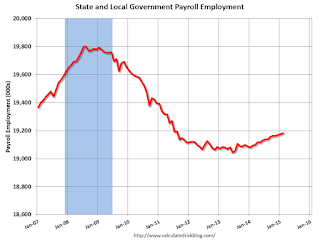 This graph shows total state and government payroll employment since January 2007. State and local governments had lost jobs for four straight years. (Note: Scale doesn't start at zero to better show the change.)
This graph shows total state and government payroll employment since January 2007. State and local governments had lost jobs for four straight years. (Note: Scale doesn't start at zero to better show the change.) In February 2015, state and local governments added 7,000 jobs. State and local government employment is now up 138,000 from the bottom, but still 620,000 below the peak.
State and local employment is now generally increasing. And Federal government layoffs have slowed (Federal payrolls were unchanged in February).
Overall this was a very solid employment report.
February Employment Report: 295,000 Jobs, 5.5% Unemployment Rate
by Calculated Risk on 3/06/2015 08:30:00 AM
From the BLS:
Total nonfarm payroll employment increased by 295,000 in February, and the unemployment rate edged down to 5.5 percent, the U.S. Bureau of Labor Statistics reported today.
...
After revision, the change in total nonfarm payroll employment for December remained at +329,000, and the change for January was revised from +257,000 to +239,000. With these revisions, employment gains in December and January were 18,000 lower than previously reported. Over the past 3 months, job gains have averaged 288,000 per month.
emphasis added
 Click on graph for larger image.
Click on graph for larger image.The first graph shows the monthly change in payroll jobs, ex-Census (meaning the impact of the decennial Census temporary hires and layoffs is removed - mostly in 2010 - to show the underlying payroll changes).
Total payrolls increased by 295 thousand in February (private payrolls increased 288 thousand).
Payrolls for December and January were revised down by a combined 18 thousand.
 This graph shows the year-over-year change in total non-farm employment since 1968.
This graph shows the year-over-year change in total non-farm employment since 1968.In February, the year-over-year change was 3.3 million jobs.
This was the highest year-over-year gain since end of the '90s.
 The third graph shows the employment population ratio and the participation rate.
The third graph shows the employment population ratio and the participation rate.The Labor Force Participation Rate decreased in February to 62.8%. This is the percentage of the working age population in the labor force. A large portion of the recent decline in the participation rate is due to demographics.
The Employment-Population ratio was unchanged at 59.3% (black line).
I'll post the 25 to 54 age group employment-population ratio graph later.
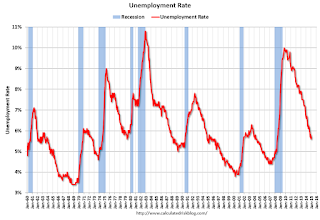 The fourth graph shows the unemployment rate.
The fourth graph shows the unemployment rate. The unemployment rate decreased in February to 5.5%.
This was above expectations of 230,000, and this was another solid report.
I'll have much more later ...
Thursday, March 05, 2015
Friday: Jobs, Trade Deficit
by Calculated Risk on 3/05/2015 06:51:00 PM
Congratulations to my friend, housing economist Tom Lawler, for winning another "Crystal Ball" award (Tom's home price forecasts were the most accurate of their more than 100 expert panelists.). This is Tom's third "Crystal Ball"!
Friday:
• At 8:30 AM ET, the Employment Report for February. The consensus is for an increase of 230,000 non-farm payroll jobs added in February, down from the 257,000 non-farm payroll jobs added in January. The consensus is for the unemployment rate to decline to 5.6% in February from 5.7% in January.
• Also at 8:30 AM, the Trade Balance report for January from the Census Bureau. The consensus is for the U.S. trade deficit to be at $41.8 billion in January from $46.6 billion in December.
• At 3:00 PM, Consumer Credit for January from the Federal Reserve. The consensus is for credit to increase $15.0 billion.
Hints of real Wage Increases
by Calculated Risk on 3/05/2015 03:04:00 PM
A few thoughts ... it seems this might be the year that we see an increase in real wages. Here are a few signs:
1) The official data suggests we are getting closer to full employment. The unemployment rate (U-3) has fallen to 5.7%, and "quits" are up significantly (voluntary separations). The number of people working part time for economic reasons is still high, but declining (these workers are included in the alternate measure of underemployment, U-6, that has fallen to 11.3% from a high of 17.1%).
2) Several companies have announced increases for their lowest paid employees, including Wal-Mart (to $9 per hour in April, and $10 per hour next year) and T.J. Maxx.
3) More labor issues. There was the West Coast port slowdown (now resolved, with a huge backup of ships waiting to unload), and the ongoing refinery strikes. From the WSJ: U.S. Refiners, Striking Workers Digging In for Protracted Battle
U.S. refiners and striking union workers are digging in for a protracted battle that could last through the spring.
...
Weeks of negotiations the union and refinery owners fell apart in early February. Since then, 6,500 USW workers have walked out of more than a dozen plants. ...
The last nationwide refinery strike was in 1980 and lasted for three months. This year, energy companies have signaled that they are willing for the work stoppage to drag on even longer. The two sides are trying to hammer out a new three-year contract that would be used as a pattern for union employment, wage increases and benefits at refineries and petrochemical plants around the U.S.
 Click on graph for larger image.
Click on graph for larger image.Union membership has declined significantly over the last 35 years (less power for labor), but these slowdowns and strikes still suggest some negotiating power for labor (we didn't see many strikes in 2008 when the economy was collapsing).
Last year I wrote that the economic word of the year for 2015 might be "wages", "Just being hopeful", I wrote, "maybe 2015 will be the year that real wages start to increase". All of the above suggests some increase in real wages this year.
Goldman February Payrolls Preview
by Calculated Risk on 3/05/2015 12:10:00 PM
Yesterday I posted a employment preview for February. Here are some excerpts from Goldman Sachs economist David Mericle:
We expect nonfarm payroll job growth of 220k in February, below the consensus forecast of 235k. Labor market indicators were mixed in February, and we expect that the effect of four major snowstorms in the month leading into the February survey week will also weigh on payroll growth. We expect a one-tenth decline in the unemployment rate to 5.6%, reversing the increase seen last month. On average hourly earnings, our baseline expectation is for a 0.2% increase, but we see some upside risk from possible statistical distortions related to the severe snowstorms.
emphasis added


